Introducing division to 3rd Graders: Effective strategies with worksheets
Hello, teachers and parents! Are you looking for fun and engaging ways to teach division to your 3rd graders? If so, you've come to the right place! In this article, we will start by introducing division to 3rd graders using fun, effective strategies and worksheets that will guide and reinforce their skills throughout the learning process.
Division means equal sharing, equal grouping, and repeated subtraction. When one number is divided by another, the number being divided is the dividend. The other number is the. The result is the quotient.
To understand more about this division, dive into these fun, engaging division worksheets from Mathskills4kids and get started!
-
Why division matters: The benefits of learning this essential skill
Before introducing division to 3rd Graders, knowing why it matters and the benefits of learning this essential skill is important.
As we know, division is one of the four basic operations of arithmetic, along with addition, subtraction, and multiplication. It is the process of splitting a number into equal parts or groups. For example, if we have 12 cookies and want to share them equally among 4 friends, we can use division to determine how many cookies each friend gets. We can write this as 12 ÷ 4 = 3, meaning each friend gets 3 cookies.
Another important reason for learning division is that it helps us solve real-world problems that involve sharing, grouping, or distributing things equally. For instance, if we want to buy a pizza for 8 people and each pizza slice costs $2, we can use division to determine how much we need to pay. We can write this as 8 x 2 = 16, meaning we need $16 to buy the pizza.
Secondly, learning division helps us understand the relationship between multiplication and division. Multiplication and division are inverse operations, meaning they undo each other. For example, if we know that 4 x 3 = 12, we can use division to determine what number times 3 equals 12. We can write this as 12 ÷ 3 = 4, meaning 4 times 3 equals 12.
Thirdly, learning division prepares us for more advanced math topics, such as fractions, decimals, percentages, ratios, proportions, and algebra. These topics require us to divide numbers in different ways and use different symbols and notations. For example, if we want to write one half as a fraction, we can use division to determine what number divided by 2 equals 1. We can write this as 1 ÷ 2 = 0.5, meaning that one-half equals 0.5.
As you can see, division is a useful and powerful skill that can help us in many situations. That's why teaching your students using effective strategies and worksheets is important for clear and quick mastery!
-
BROWSE THE WEBSITE
-
DOWNLOAD FREE WORKSHEETS
-
-
3rd GRADE MATH TOPICS
- Number and compapring
- Place value
- Addition
- Subtraction
- Understand multiplication
- Multiplication skill builders
- Multiplication fluency
- Multiplication
- Understand division
- Division skill builders
- Division fluency
- Division practice
- Mixed operation
- Properties
- Equations & variations
- Estimate & rounding
- Logical reasoning
- Patterns
- Money
- Telling time
- Data graph & probability
- Understanding fractions
- Equivalent fractions
- Comparing and ordering fractions
- Operations with fractions
- Unit of measurement
- Two-dimensional shapes
- Triangles and quadrilaterals
- 3D shapes
- Geometric measurement
-
-
Equal groups division practice
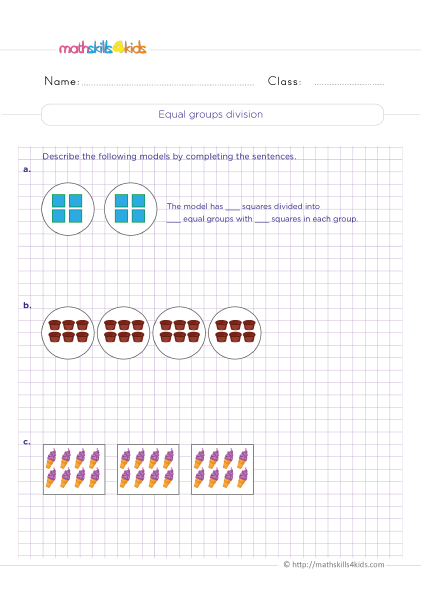 Print it...
Print it...
-
How to write and evaluate division sentences using equal groups?
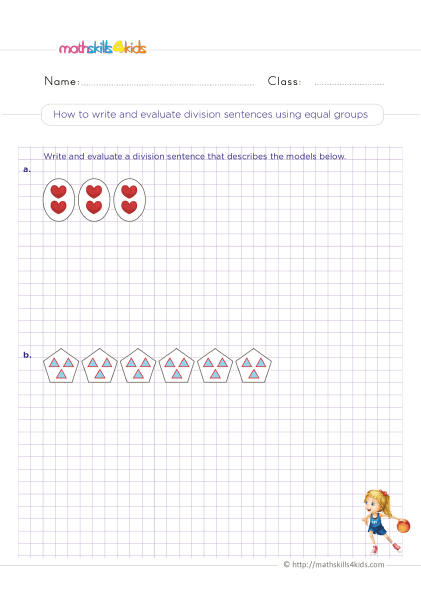 Print it...
Print it...
-
Relating multiplication and division using equal groups
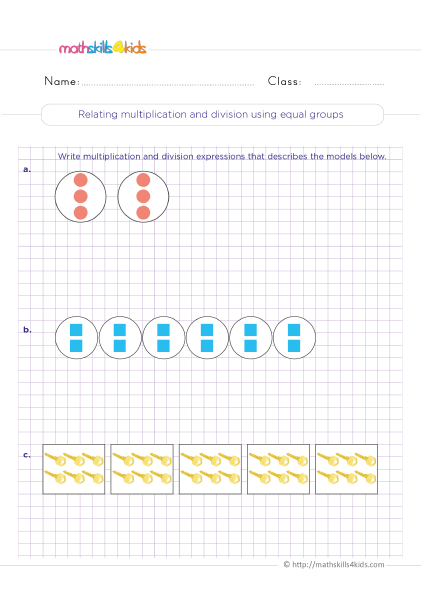 Print it...
Print it...
-
Writing and evaluating division sentences using arrays
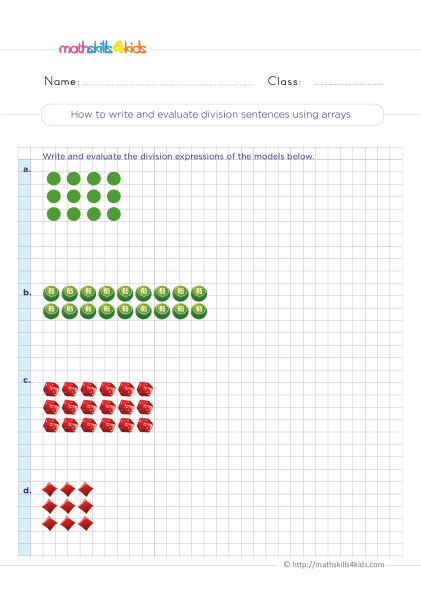 Print it...
Print it...
-
Relating multiplication and division using arrays
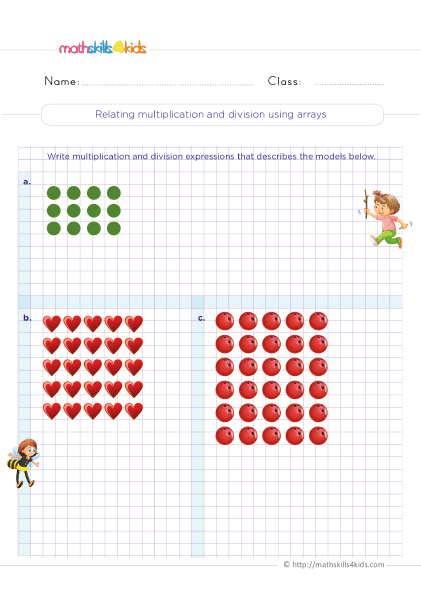 Print it...
Print it...
-
Equal groups division practice
-
Buying is supporting us!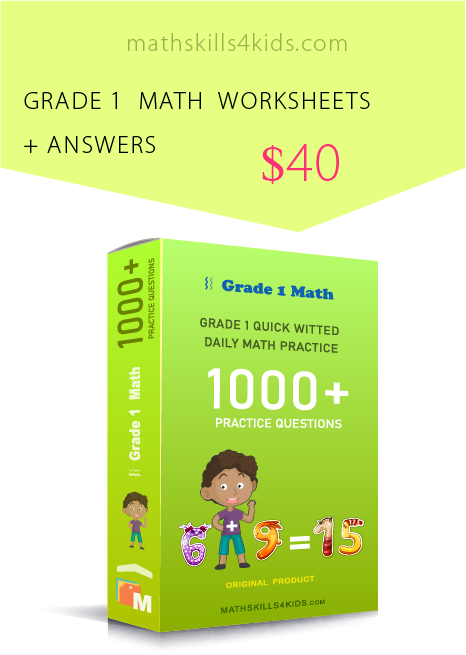
Buy Now...
-
-
How to explain division to 3rd Graders: Simple and fun methods
Division can be challenging for many 3rd graders, but it shouldn’t be boring or frustrating. There are many ways to make division fun and easy to understand for your students. Here are some simple and fun methods to explain division to 3rd graders:
- Use manipulatives. Manipulatives can be moved, counted, or grouped to represent mathematical concepts. You can use anything from buttons, coins, beads, blocks, or even candy to show your students how division works.
For example, you can give your students 12 candies and ask how they can divide them equally among 3 friends. Then, have them use the candies to make 3 equal groups of 4.
Explain that this is one way to divide: by making equal groups and finding how many are in each group.
- Use stories. Stories are a great way to engage your students and help them relate division to real-life situations. You can use books, videos or even make up your own stories that involve dividing something among people or things.
For example, you can read a story about a farmer who has 15 cows and wants to put them in 5 pens. Then, ask your students how they can do that. Have them draw pictures or use manipulatives to show how he can divide the cows into 5 equal groups of 3.
Explain that this is another way to divide: by finding how many groups of a certain size you can make from a larger group.
- Use songs. Songs are a fun way to help your students remember the facts and rules of division. You can use existing or makeup songs that rhyme or have catchy tunes. For example, you can sing a song like this:
Division is easy when you know what to do
You have to split things into equal groups
You can use objects or pictures or numbers too
And then you'll find the answer without any loops
Division is easy when you know what to do
You have to find how many times something fits
You can use multiplication or skip counting too
And then you'll find the answer without any splits - Use manipulatives. Manipulatives can be moved, counted, or grouped to represent mathematical concepts. You can use anything from buttons, coins, beads, blocks, or even candy to show your students how division works.
-
Understanding equal groups division
One of the most common ways of building division skills in kids is by helping them understand equal group division. To make equal groups, take a larger group of things and split it into smaller groups that have the same number of things in each group. For example, if you have 12 apples and you want to divide them into 4 equal groups, you can make 4 groups of 3 apples each.
To write a division sentence using equal groups, you need three numbers: the total number of things (the dividend), the number of groups (the divisor), and the number of things in each group (the quotient). The division sentence looks like this:
dividend ÷ divisor = quotient
For example, if you have 12 apples and you want to divide them into 4 equal groups, you can write:
12 ÷ 4 = 3
This means that 12 apples divided into 4 groups equals 3 apples in each group.
To evaluate a division sentence using equal groups, check if the quotient is correct. You can do this by multiplying the divisor and the quotient and seeing if you get the dividend. This is called the inverse operation of division. For example, if you have this division sentence:
15 ÷ 5 = 3
You can check if it is correct by multiplying the divisor and the quotient:
5 x 3 = 15
This means the division sentence is correct because 15 divided by 5 equals 3, and 5 times 3 equals 15.
-
Relating multiplication and division using equal groups
Another way to understand division is by relating it to multiplication using equal groups. Multiplication and division are inverse operations, meaning they undo each other. For example, if you multiply 4 by 3, you get 12. If you divide 12 by 4, you get back to 3.
You can use this relationship to help you solve division problems using equal groups. For example, if you have this division problem:
24 ÷ ? = 6
You can think of it as a missing factor problem in multiplication:
? x 6 = 24
Then, you can use your knowledge of multiplication facts or skip counting to find the missing factor:
4 x 6 = 24
This means that the missing factor is 4, and the answer to the division problem is also 4:
24 ÷ ? = 6
24 ÷ 4 = 6
-
How to write and evaluate division sentences using arrays
Another way to divide is by using arrays. Arrays are arrangements of objects or numbers in rows and columns that form a rectangle. For example, this is an array of 12 stars:
* * * *
* * * *
* * * *To write a division sentence using arrays, you need three numbers: the total number of things (the dividend), the number of rows (the divisor), and the number of things in each row (the quotient). The division sentence looks like this:
dividend ÷ divisor = quotient
For example, if you have an array of 12 stars with 3 rows and 4 stars in each row, you can write:
12 ÷ 3 = 4
This means 12 stars divided into 3 rows equals 4 stars in each row.
To evaluate a division sentence using arrays, you need to check if the quotient is correct. You can do this by multiplying the divisor and the quotient and seeing if you get the dividend. This is called the inverse operation of division.
- For example, if you have this division sentence: → 18 ÷ 6 = 3
- You can check if it is correct by multiplying the divisor and the quotient: → 6 x 3 = 18
- This means the division sentence is correct because 18 divided by 6 equals 3, and 6 times 3 equals 18.
-
Relating multiplication and division using arrays
You can also use arrays to relate multiplication and division. Multiplication and division are inverse operations, meaning they undo each other. For example, if you multiply 3 by 4, you get 12. If you divide 12 by 3, you get back to 4.
You can use this relationship to help you solve division problems using arrays. For example, if you have this division problem:
? ÷ 2 = 5
You can think of it as a missing factor problem in multiplication: →? x 2 = ?
Then, you can use an array to find the missing factor. You can make an array with 2 rows and 5 things in each row:
* * * * * *
* * * * * *Then, you can count how many things are in the array: →10
This means that the missing factor is 10, and the answer to the division problem is also 10:
? ÷ 2 = 5
10 ÷ 2 = 5
-
Tips and tricks for introducing division to 3rd graders: How to help your students succeed with effective division strategies and worksheets
Division can be tricky, but there are some tips and tricks for introducing division to 3rd graders. Also, visit Mathskills4kids.com and discover some effective strategies and worksheets to help your students succeed and become masters of division-solving.
Here are some of the tips:
- Use mnemonics. Mnemonics are memory aids that help you remember something by using words, phrases, or images. For example, you can use the acronym DMSB to remember the steps of long division: Divide, Multiply, Subtract, and Bring down.
You can also use phrases like "Does McDonald's Sell Burgers?" or "Dad, Mom, Sister Brother" to remember the same steps.
- Use patterns. Patterns are regular or repeated arrangements of things that help you predict or find something. For example, you can use patterns to help you divide by powers of ten. When you divide by ten, you move the decimal point one place to the left.
When you divide by a hundred, you move it to two places to the left. When you divide by a thousand, you move it three places to the left, and so on.
- Use shortcuts. Shortcuts are quick or easy ways to do something that saves time or effort. For example, shortcuts can help you divide by certain numbers. When you divide by two, you halve the number. When you divide by five, you multiply by two and move the decimal point one place to the left. When you divide by nine, you add up the digits of the number and see if they are divisible by nine.
- Use mnemonics. Mnemonics are memory aids that help you remember something by using words, phrases, or images. For example, you can use the acronym DMSB to remember the steps of long division: Divide, Multiply, Subtract, and Bring down.
Division games and projects: Creative and collaborative ways to introduce and reinforce division learning to 3rd graders
One of the best ways to help your students master division is to make it fun and engaging. There are many online and offline games, projects, effective strategies, and worksheets that you can use to introduce and reinforce division learning to your 3rd graders in a creative and collaborative way.
Here are some examples:
- Prodigy Math Game: This free online game adapts to your student's level and covers various math topics, including division. Your students can create their avatars, explore a fantasy world, and battle monsters using math skills.
You can also assign specific division skills for them to practice and track their progress. Learn more at https://www.prodigygame.com/main-en/blog/division-activities/.
- Guess What?: This is a game based on Guess Who? where your students have to guess each other's secret number by asking yes or no questions involving division. For example, "Is your number divisible by 3?" or "Does your number have a remainder of 2 when divided by 5?" This game helps with reasoning and divisibility rules.
Learn how to make it here: https://www.pinterest.com/pin/guess-who-math-games-division--401313016802351999/
- Jelly Bean Division: This is a hands-on activity where your students sort jelly beans into an egg carton as equally as possible. They can use different strategies, such as skip counting, repeated subtraction, or grouping by twos or threes.
This activity helps with understanding equal groups division and finding remainders. Learn more here: https://www.teacherspayteachers.com/Product/Jelly-Bean-Multiplication-Division-Activity-Pack-3OA7-3NBT3-593682.
- Division Art: This is a project where your students create their artwork using arrays or area models of division. They can use different materials, such as paper, stickers, stamps, or tiles, to make arrays or area models. Then they write the corresponding division sentence on their artwork.
This project helps with visualizing division and relating multiplication and division. See some examples here: https://www.pinterest.com/pin/154811305921601713/.
From the many benefits and importance of division in 3rd graders and our daily lives, we can conclude that division is an essential skill your students need to learn for future math studies and real-life situations.
Thank you for sharing the links of MathSkills4Kids.com with your loved ones. Your choice is greatly appreciated.
-
You can find the best strategies and worksheets for introducing division to 3rd graders at Mathskills4kids.com.
However, by using effective strategies and worksheets, such as relating division to multiplication, using models and manipulatives, and playing games and projects, you can make teaching division easier and more fun for you and your students.
Remember to celebrate their achievements and encourage them to keep practicing until they become confident and fluent in solving division problems.
